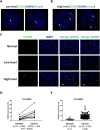Coexpression of CD44-positive/CD133-positive cancer stem cells and CD204-positive tumor-associated macrophages is a predictor of survival in pancreatic ductal adenocarcinoma
- PMID: 24839953
- PMCID: PMC4232049
- DOI: 10.1002/cncr.28774
Coexpression of CD44-positive/CD133-positive cancer stem cells and CD204-positive tumor-associated macrophages is a predictor of survival in pancreatic ductal adenocarcinoma
Abstract
Background: The interactions between cancer stem cells (CSCs) and tumor-associated macrophages (TAMs) can promote tumor progression, maintain the CSCs population, and reduce therapeutic effects. The objective of this study was to investigate the coexpression of CSCs and TAMs and its clinical significance in pancreatic ductal adenocarcinoma (PDAC).
Methods: Ninety-six patients with PDAC were included in this study. Tissue microarrays were constructed for immunostaining of the CSCs markers CD44 and CD133 and the TAMs marker CD204. Correlations between the expression of CSCs and TAMs markers and clinicopathologic characteristics or disease progression were analyzed.
Results: Expression levels of CD44/CD133 and CD204 were significantly higher in tumor tissues than in normal tissues (P < .0001). The variables associated with survival were high coexpression of CD44/CD133 (P = .000), high expression of CD204 (P = .011), and tumor grade (P = .014). There was a positive correlation between CD44/CD133 and CD204 expression (r = 0.294; P = .004). Survival analysis indicated that high coexpression of CD44/CD133 and CD204 was associated significantly with shorter overall survival (P = .000) and disease-free survival (P = .003). Multivariate analysis revealed that high CD44/CD133 expression was an independent prognostic factor for disease-free survival, whereas high CD204 expression was an independent predictor for both overall and disease-free survival.
Conclusions: Coexpression of CD44/CD133 and CD204 is a useful survival prediction marker for patients with PDAC.
Keywords: CD133; CD204; CD44; cancer stem cells; pancreatic ductal adenocarcinoma; tissue microarrays; tumor-associated macrophages.
© The Authors. Cancer published by Wiley Periodicals, Inc. on behalf of American Cancer Society.
Figures



References
-
- Bilimoria KY, Bentrem DJ, Ko CY, et al. Validation of the 6th edition AJCC Pancreatic Cancer Staging System: report from the National Cancer Database. Cancer. 2007;110:738–744. - PubMed
-
- Siegel R, Naishadham D, Jemal A. Cancer statistics, 2013. CA Cancer J Clin. 2013;63:11–30. - PubMed
-
- Michl P, Gress TM. Current concepts and novel targets in advanced pancreatic cancer. Gut. 2013;62:317–326. - PubMed
-
- Abel EV, Simeone DM. Biology and clinical applications of pancreatic cancer stem cells. Gastroenterology. 2013;144:1241–1248. - PubMed
Publication types
MeSH terms
Substances
LinkOut - more resources
Full Text Sources
Other Literature Sources
Medical
Research Materials
Miscellaneous

